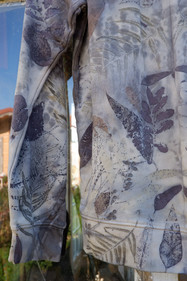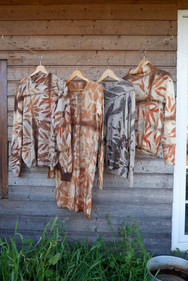Seasonal Profile: Winter Evergreens
- annettebrinckerhof
- Oct 21
- 4 min read

Plant Spotlight
Eucalyptus (Eucalyptus spp.)
The Eucalyptus is a sacred tree native to Australia, with over 700 species that are now planted all over the world. In Portugal, it is an extremely controversial plant associated with vast monocultures planted by the paper industry that intensify Portugal's problematic wildfires and have replaced a lot of its native fire resilient forests. For natural dyer's it is a generous and exciting source of color. I would even say that it was the original ecoprinting plant used by India Flint.
Eucalyptus is highly medicinal, known for its antimicrobial properties. The trees are often used in regenerative Agroforest techniques as windbreaks, for shade, and essential organic material - eventually being replaced with other species as the food forest matures. It is a tree with so much to give when understood and managed correctly. Naturally, when humans degrade the native landscape and densely overplant eucalyptus to suit financial interests of a few, there will be consequences.
In the winter collection, eucalyptus leaves from various varieties make the striking red and orange prints on wool. Naturally sheading bark from the eucalyptus is also used for a lovely pinkish-brown.
Acacia (Acacia dealbata, A. melanoxylon, and others)
Another Australian native that is controversial in Portugal, acacia has spread widely in Portugal because of its ability to quickly germinate after fires. Like eucalyptus, it was first introduced to Portugal in the 1800's for its economic and ornamental value. A descreasein economic interest reducing harvest, lack of management and an erroded ecosystem have made it easy for Acacia species to take over.
When managed properly, this leguminous tree regenerates degrated soils by making nitrogen in the air available to plants in the soil through a symbiotic relationship with a bacteria in the roots.
Another interesting thing about acacia is that the long leaves aren't really leaves - they're flattened stems called phylodes, which don't transpire water and makes them highly resistant to drought! The true leaves are feather-shaped. Whether phylode or leaf, acacia makes beautiful prints.
Casuarina (Casuarina equisetifolia)
Casuarina is known in Portugal commonly as an Australian Pine, but I prefer to call it a messy pine. This tall, fast growing tree is native to Australia (hence the common name) and was introduced for windbreaks and coastal stabilization. Unlike Eucalyptus and Acacia, it has been naturalized in the country - even listed on the ICNF's website as an approved tree for foresting. In Portugal, it lines many roadsides and is used as a living fence.
In the studio, Casuarina makes the most incredible, delicate prints. A dependable, beginner friendly leaf which stand out from the more traditional leaf shapes.
Grevillea (Grevillea robusta)
Also from Australia, grevillea is a common ornamental tree in southern Portugal. Its fern-like leaves and orange-red flowers make it a favorite for gardens and public spaces. Like casuarina, it is naturalized in Portugal because it grows easily without becoming invasive, illustrating how context determines whether a species is perceived as “problem” or “companion.”
I first noticed Grevillea's striking leaves on the ground by my sister's apartment. I identified the tree growing behind a high school's fence, so shyly went up to the guard to ask if I could come in to collect leaves despite clearly not being a student. He was confused and suspicious, but let me gather the leaves from the ground. It took only a few days to realize how silly it was, because now that my eyes are opened to them I find them everywhere.
Araucaria (Araucaria heterophylla)
Known as the Norfolk Island Pine because it's endemic to Norfolk island of Australia, this striking conifer was introduced as a decorative tree in aristocratic estates and botanical gardens. Portugal’s oldest specimens stands in the Monteiro-Mor Botanical Garden in Lisbon. Its symmetry and towering height make it both architectural and ancient. When boiled, its tough leaves release brick-red tones that pair beautifully with the greys and greens of the season.
Concept & Inspiration
Winter in Portugal doesn’t bring snow or complete dormancy. While the garden rests, deciduous trees are bare, and the weeds are still growing, it's the introduced evergreens that keep me busy in the studio.
All the winter plants - Eucalyptus, Acacia, Casuarina, Grevillea, and Araucaria - are introduced species in Portugal, yet they are spoken about in very different ways. Eucalyptus is vilified as destructive, but its impact comes from how humans have used it - replacing diverse forests with monocultures driven by private interests. By contrast, trees like Casuarina and Grevillea are rarely questioned, even though they are just as foreign, because they 'behave' without taking over the landscape. These examples show that what we call “invasive” is often less about the plant itself and more about how people choose to relate to them.
Their reputations mirror human choices more than their own behavior. Land management, not origin, determines balance. In winter, these evergreen trees remind me that nature doesn't deal in good nor bad, it’s just tring .to live and find a balance These trees remind me that plants have no borders. They root where they can, responding to the conditions we create.
The STAR pieces of the winter collection are definitely the wool pieces. Vintage wool garments are repurposed with (primarily) eucalyptus trees, which have the unique ability to print red and orange colors exclusively on protein fabrics. The most vilified plant in the list becomes the most intersting in the studio. Keep your eye out for these classic ecoprint designs in the Winter collection.


















































































































Comments